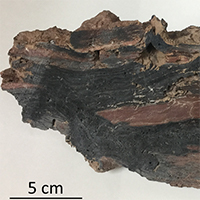STE Highlights, December 2020
Awards and Recognition
Accelerator Operations and Technology
Novel adaptive machine-learning approach improves reproduction of internal 3D structure
Bioscience
Microbial interactions, not individual microorganisms, essential to carbon cycling in soil
Capability Enhancement
LANL-developed system offers better, faster, safer decontamination of surfaces
Novel thermal neutron detector safeguards aircraft and HPC semiconductor electronics
Computer, Computational and Statistical Sciences
Novel “fast-forwarding” quantum algorithm makes quantum computing more useful right now
X-Computational Physics
New ICF platform and high-res imaging provide groundwork for direct drive multi-shell targets
Awards and Recognition
LANL scientist and collaborator honored by mineral name
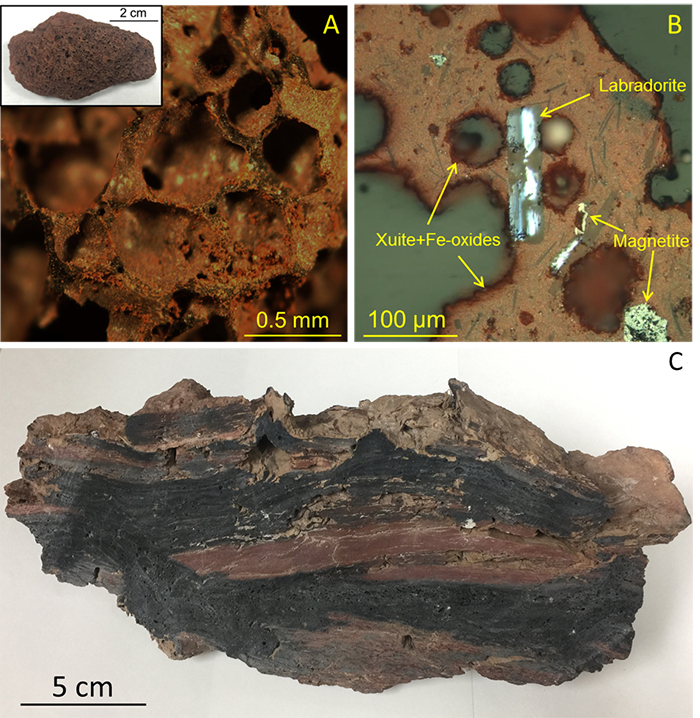
(A) Reddish-brown scoria specimen showing porous texture with vesicles covered by oxide minerals of xuite, luogufengite, hematite, and maghemite. (B) A polished surface of a scoria thin section shows brownish coating of the oxides on the vesicle surfaces. (C) A co-type specimen of paralava sample from Wyoming. The reddish area contains the xuite, hematite, and silica-rich glass.
Hongwu Xu, a LANL Earth System Observations (EES-14) scientist, and his University of Wisconsin collaborator Huifang Xu were recently honored in a unique way. The scientists had a mineral named after them: xuite.
Xuite was initially discovered in Idaho as part of a reddish-brown scoria specimen from the Menan Volcanic Complex. The reddish glass on the scoria surface contains the new mineral. More recently, xuite was identified in a second location—naturally combusted coal beds in Gillette, Wyoming.
Xuite is challenging to characterize, but it was successfully identified using high-resolution synchrotron X-ray diffraction and high-resolution transmission electron microscopy. Xuite’s chemical formula was determined to be Ca3Fe2[AlO3(OH)]3, and it was classified as a member of the garnet group.
The International Mineralogical Association approved the honored naming. Both scientists are considered expert mineralogists as well as elected Fellows of the Mineralogical Society of America (MSA). Additionally, Hongwu Xu is the current Chief Editor for MSA’s flagship journal, American Mineralogist: International Journal of Earth and Planetary Materials Research.
Technical contact: Hongwu Xu
Accelerator Operations and Technology
Novel adaptive machine-learning approach improves reproduction of internal 3D structure
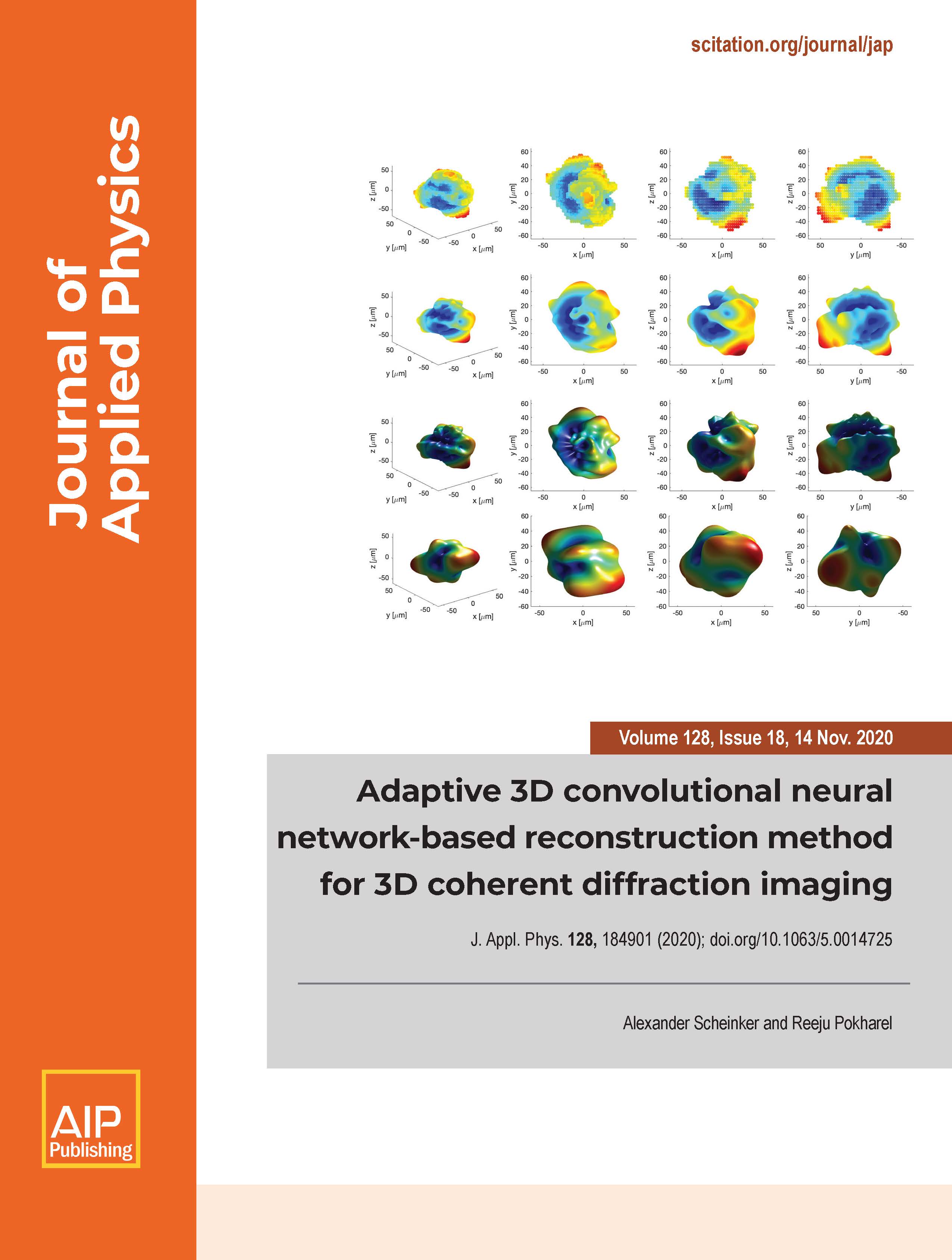
The novel reconstruction method was featured on the cover of the Journal of Applied Physics.
Los Alamos researchers in Accelerator Operations and Technology (AOT-RF) and Materials Science in Radiation & Dynamics Extremes (MST-8) developed a novel machine learning-based approach for reconstructing three-dimensional crystals. With the new technique, an initial reconstruction “guess” is made quickly and with little computational expense, with a subsequent fine-tuning incorporated afterward.
“We created an adaptive machine learning framework that uses a combination of a 3D convolutional neural network together with an ensemble of model-independent adaptive feedback agents to reconstruct 3D volumes,” says Alex Scheinker, lead author (AOT-RF).
Model independence is important because it allows the researchers to consider larger numbers of coefficients, such as tuning up to 225 spherical harmonics and 1,000 radial basis functions simultaneously. It also enhances the robustness of the technique to measurement noise and to changing experimental setups.
The new technique is particularly beneficial because it offers more than just a picture.
“The end product is not just an image or 3D density volume, but actually an analytic representation of the reconstructed object density,” Scheinker says.
The proof-of-concept work was published in the Journal of Applied Physics and selected as the cover feature. The researchers plan to extend this reconstruction method to reproduce the phases of more complex crystals with defects and dislocations in real time for DMMSC-type measurements.
Funding and mission
This work was supported by the LANL Institute of Materials Science Rapid Response project. The research supports the Laboratory’s Nuclear Deterrence mission area and the Integrating Information, Science, and Technology for Prediction capability pillar.
Reference: A. Scheinker and R. Pokharel. “Adaptive 3D convolutional neural network-based reconstruction method for 3D coherent diffraction imaging.” Journal of Applied Physics 128, 184901 (2020). https://doi.org/10.1063/5.0014725
Technical contact: Alex Scheinker
Bioscience
Microbial interactions, not individual microorganisms, essential to carbon cycling in soil

Carbon flow from litter decomposition in soil depends on the team of microbes. (A) Microbial communities vary in performance, like sports teams. (B) Microbial communities that vary dramatically in performance generally vary in composition (types of organisms, measured by DNA sequencing). But in some cases, the compositions are quite similar (proximity of points indicates similarity), which suggests the interactions among team members account for performance differences. (C) Emergent characteristics of communities also point to interactions among members as a key factor in performance differences.
New studies at Los Alamos demonstrate that microbial interactions in soil—and not just individual microorganisms—are critical in determining how the entire soil community cycles carbon through the ecosystem.
“One might expect a few species to out-compete others based on superior ability,” said John Dunbar, project lead, Bioenergy and Biome Sciences (B-11). “However, what we found is similar to a sports team that can’t win based on the ability of one star player: the sports team needs diverse abilities, and crucially, superior interactions among team members. So does the microbiome.”
The findings could help improve carbon cycling models and elucidate ways for scientists to adapt microbiomes to increase carbon storage for improving soil health, agriculture, sustainable biofuels production, and other applications.
“We are searching for traits or markers that would be useful for modeling soil carbon or to help us manipulate soil populations to increase carbon sequestration,” Dunbar said.
Fungi and bacteria cycle nutrients through the decomposition of organic matter, such as plant litter. During decomposition, some carbon is released into the atmosphere as carbon dioxide and some remains stuck in the soil as dissolved organic carbon (DOC). As part of the Terrestrial Microbial Carbon Cycling Science Focus Area at Los Alamos, the scientists created microcosms of 206 different soil communities with which they could study plant litter decomposition in a controlled environment. Over a six-week period, the scientists measured carbon flow and sampled the soil to study diversity of the microbial species (species richness) and evaluate microbial gene activity, which could help identify the organisms’ specific roles in carbon cycling.
Because there are so many variables at play in different soil environments—temperature, pH, nutrients, precipitation, contaminants—the microcosms gave the scientists a simple experimental system to aid in clarifying the independent role of microbial composition. The DOC, species richness, and gene activity measurements aim to reveal the features that enhance carbon sequestration versus those that amplify carbon release.
Through their analysis of the microcosm data, Dunbar and his colleagues concluded that the interactions among the organisms in the soil are critical in determining how the entire community cycles carbon. In fact, there were no particular microbes dominating each population—each microcosm had significant species richness.
This finding caused a dramatic shift in the focus of future research by convincing the team that in order to manipulate community function, the research must focus on how the microbes interact with each other rather than the physiology and functions of individuals.
The research was published in Frontiers in Microbiology and FEMS Microbiology Ecology and and was also featured in a DOE blog post in August. In addition, Dunbar explained that recent field experiments—yet to be published—demonstrated this same phenomenon in the field over a year-long experiment to compare microcosm data with the natural environment.
Funding and mission
This research was conducted under the Los Alamos National Laboratory Science Focus Area (SFA) program in Microbial Carbon Cycling funded by the U.S. Department of Energy’s Biological and Environmental Research (BER) Division. The work supports the Laboratory’s Energy Security mission area and the Science of Signatures capability pillar.
References:
Albright MBN, Johansen R., Thompson J., Lopez D., Gallegos-Graves L.V., Kroeger M.E., Runde A., Mueller R.C., Washburne A., Munsky B., Yoshida T., and Dunbar J. “Soil Bacterial and Fungal Richness Forecast Patterns of Early Pine Litter Decomposition.” Front. Microbiol. (2020) 11:542220. https://doi.org/10.3389/fmicb.2020.542220
Michaeline B N Albright, Jaron Thompson, Marie E. Kroeger, Renee Johansen, Danielle E M Ulrich, La Verne Gallegos-Graves, Brian Munsky, John Dunbar. “Differences in substrate use linked to divergent carbon flow during litter decomposition.” FEMS Microbiology Ecology, Volume 96, Issue 8, August 2020, fiaa135, https://doi.org/10.1093/femsec/fiaa135
DOE-BER blog: https://www.energy.gov/science/ber/articles/traits-microbes-matter-microbial-carbon-cycling-and-storage
Technical contact: John Dunbar
Capability Enhancement
LANL-developed system offers better, faster, safer decontamination of surfaces
Necessity often spurs invention, and that is precisely what led to the development of a novel decontamination system fully designed and tested at Los Alamos.
“The Los Alamos mission to produce 30 pits per year requires the removal of many enclosures and other equipment from the Plutonium Facility,” says Ben Karmiol, Actinide Material Processing & Power (AMPP-3: ARIES). “Prior to removal, these actinide-contaminated items must be decontaminated, but the usual process demands significant manual labor—increasing safety risks as well as waste generation, and it’s not always successful.”
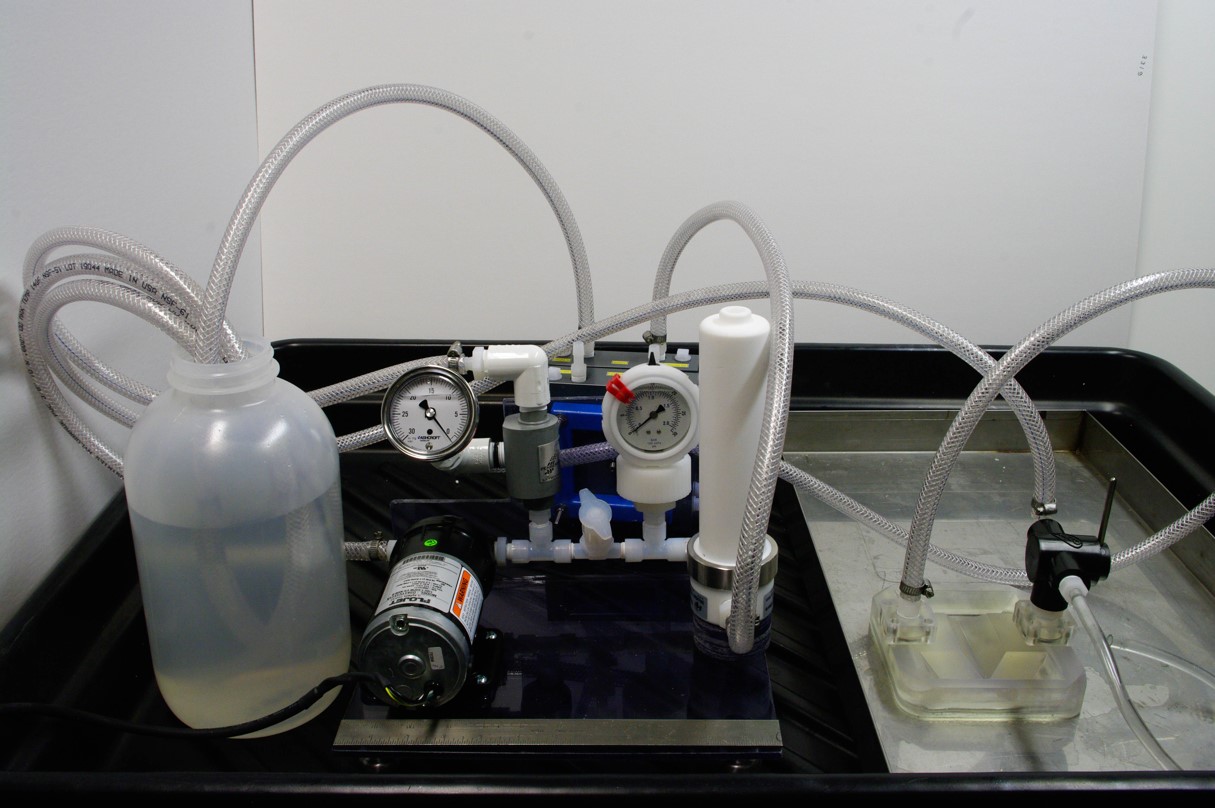
Pictured is the proof-of-concept decontamination system, which can be used in varying setups.
A new technology was needed, one that could decontaminate effectively while reducing waste generation and dose rates. The Los Alamos researchers came up with an integrated electrochemical decontamination and etching system that employs a reusable cleaning solution of highly oxidizing ions. These ions dissolve tough actinide oxides as well as other metal alloys and oxides, leaving behind a decontaminated, etched surface that is ideal for coating adhesion. The researchers have tested nanoparticle-enhanced coatings on the decontaminated surfaces and found superior adhesion and protection. It’s a technology with two-fold benefit: decontamination of surfaces and an opportunity to protect those same surfaces.
Currently, the project is seeking an industrial partner through the Feynman Center for Innovation to further the scale up and applications. This technology can be used to decontaminate containment tanks, enclosures, and parts in nuclear facilities or other industrial facilities either as regular maintenance or for decommissioning.
“The world of decontamination needs is vast. Because our technology uses a continuously regenerated super acid, it has the ability to clean many surfaces, while offering an efficient and recyclable solution,” Karmiol says.
The newest version of the metal decontamination technology will be available in late January. It will demonstrate one of the most critical elements of the technology: integration of techniques stemming from a variety of scientific disciplines. Chemistry expertise, engineering expertise, analytical techniques, and acoustic monitoring techniques are some of the many features of the system that come together to create this novel technology.
Funding and mission
The Integrated Electrochemical Decontamination and Etching System was initially funded by a LANL Laboratory Directed Research and Development (LDRD) award. The technology supports the Laboratory’s Nuclear Deterrence mission area and the Complex Natural and Engineered Systems capability pillar.
References:
“Integrated Electrochemical Decontamination and Etching System,” Feynman Center for Innovation Tech Snapshot. October 2020. Technology (lanl.gov)
Provisional Patent: DOE Reference: S-133,812.000
Technical contact: Ben Karmiol
Novel thermal neutron detector safeguards aircraft and HPC semiconductor electronics
Los Alamos researchers collaborated with Honeywell, Inc., to develop the Tinman technology to detect deleterious levels of thermal neutrons.
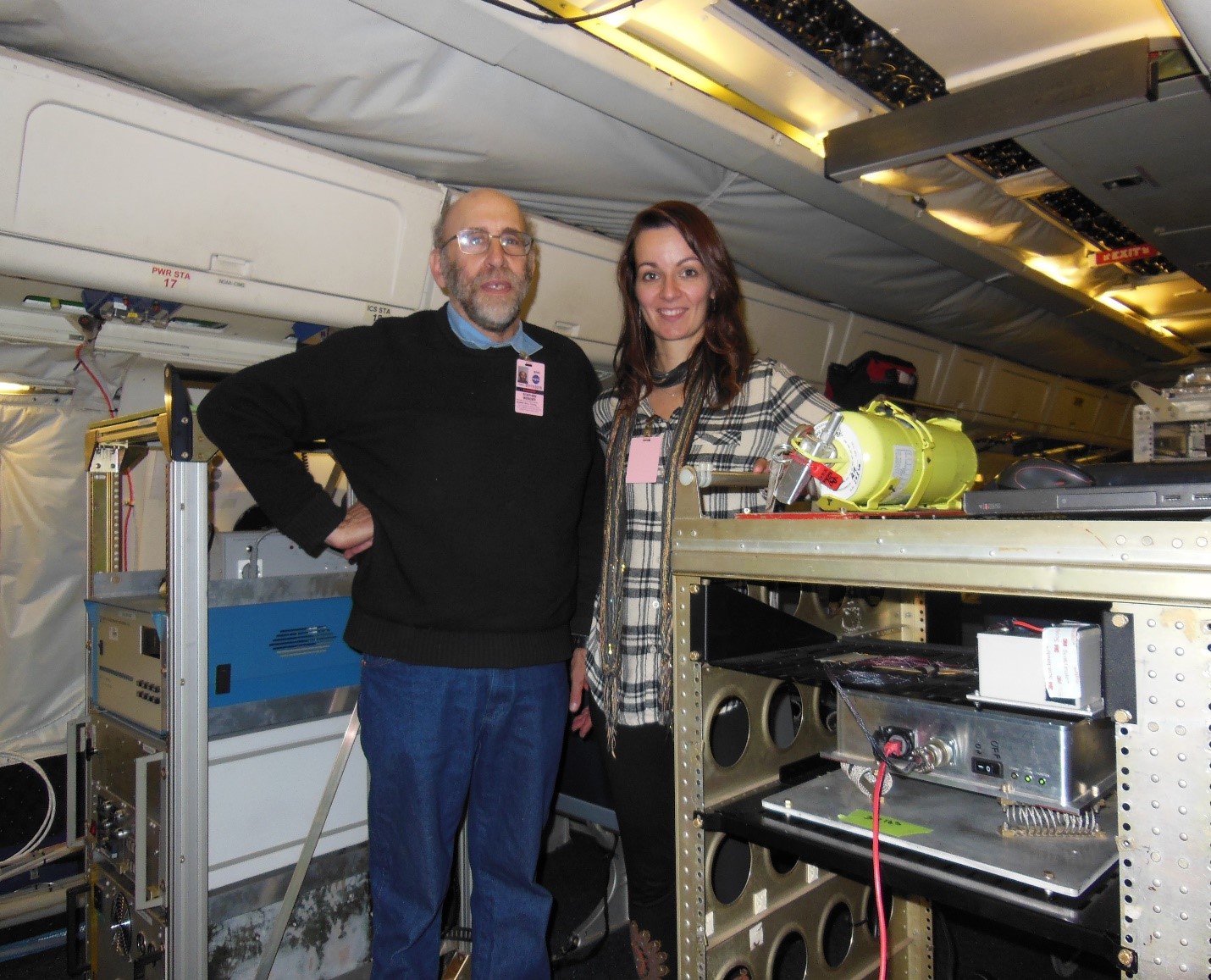
Steve Wender (P-27) and Suzanne Nowicki (ISR-1) are shown in the cabin of a NASA DC-8 aircraft for testing. The Tinman instrument is in the rack with a red ethernet cable connected to it.
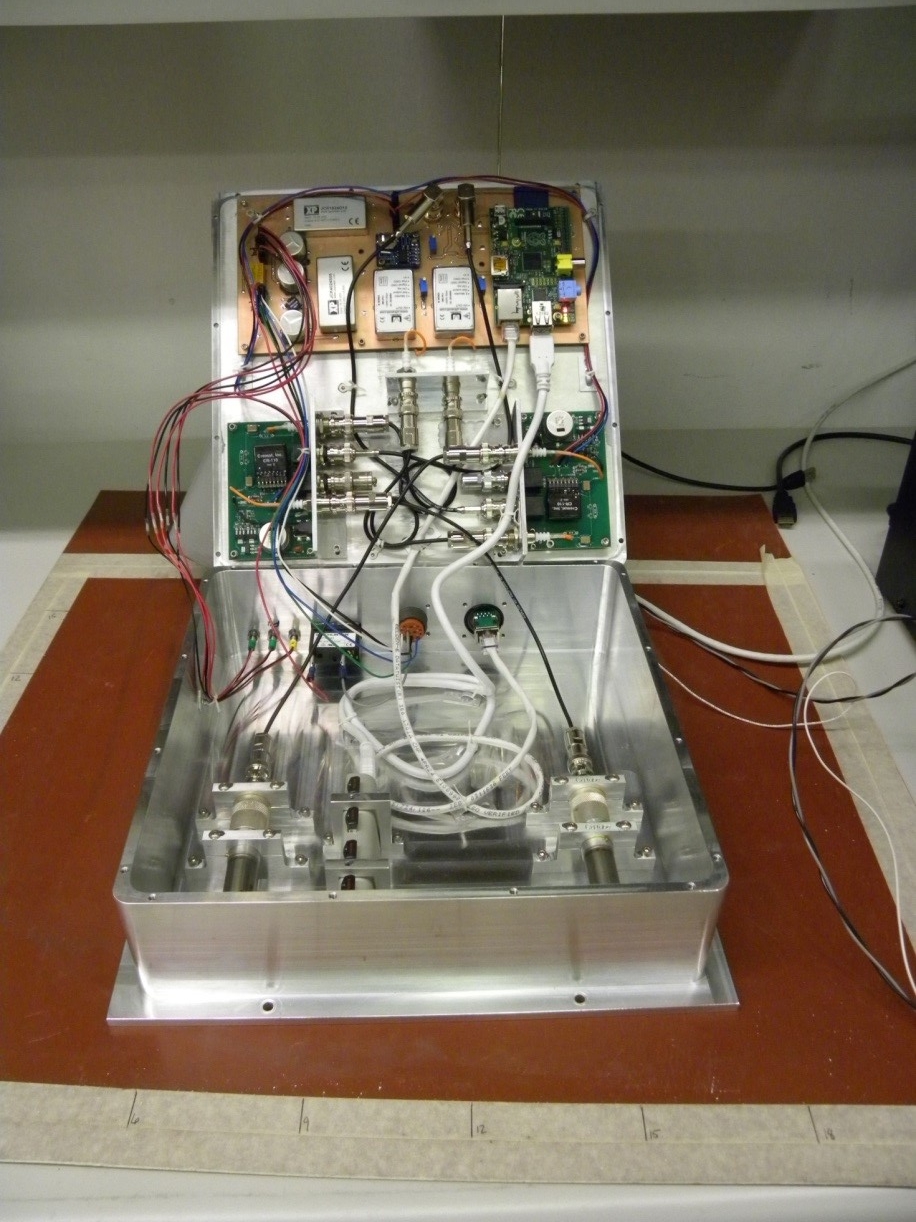
Inside the Tinman detector, the bottom contains the two He-3 tubes and the lid contains the signal processing electronics, the power supplies, and the Raspberry Pi computer.
It has long been recognized that high-energy neutrons can impact the reliability of semiconductor devices by producing ionized particles that deposit charge in semiconductor devices. There have been recent concerns that thermal neutrons can also cause failures by creating charged particles following nuclear reactions. These thermal neutrons are produced when high-energy neutrons strike moderating material and lose energy. Approximately 10–20 percent of single-event upsets seen in semiconductors have been attributed to thermal neutrons.
Certain environments, including high-performance computing (HPC) environments and aircraft may be particularly susceptible to thermal neutrons. In the case of HPC, there is a significant amount of cooling water near the semiconductor devices. In aircraft, there is considerable fuel in the aircraft. Both water and fuel are excellent thermalizing materials. Therefore, both industries are invested in detecting and understanding the thermal neutron environment.
Tinman does precisely that—it detects and measures thermal neutrons via He-3 tubes, one of which is covered with cadmium while the other is bare. The thermal neutron intensity is the difference in count rates between the two tubes.
Tinman is autonomous and has already been successfully tested on three different NASA aircraft flights. Tin-II is a recent advancement specifically designed for detection of thermal neutrons in the Los Alamos HPC facility. Tin-II was installed and has been operating in the HPC area for approximately one year. In addition, a version of Tinman is being designed to detect thermal neutrons as part of the Coherent Captain Mills neutrino experiment at LANSCE.
Research and development work is ongoing between LANL and Honeywell under a CRADA for the next-generation Tinman detector.
Funding and mission
Tinman technology is funded by a Strategic Partnership agreement and now a CRADA with Honeywell. The technology supports the Laboratory’s Nuclear Deterrence mission area and the Science of Signatures capability pillar.
Reference:
Wender, A. Couture, and T. Fairbanks, “Report on the Tin-II thermal Neutron Detector.” LA-UR 19-30822 https://permalink.lanl.gov/object/tr?what=info:lanl-repo/lareport/LA-UR-19-30822
Technical contact: Steve Wender
Computer, Computational and Statistical Sciences
Novel “fast-forwarding” quantum algorithm makes quantum computing more useful right now
A Los Alamos-developed algorithm brings the long-sought-after possibility of quantum simulation with quantum computers nearer to reality. Scientists have pursued quantum computing for decades in an effort to better simulate quantum systems, which obey different physical laws and rules than classical systems. However, quantum computing has thus far been plagued by several barriers—the most prominent of which is noise.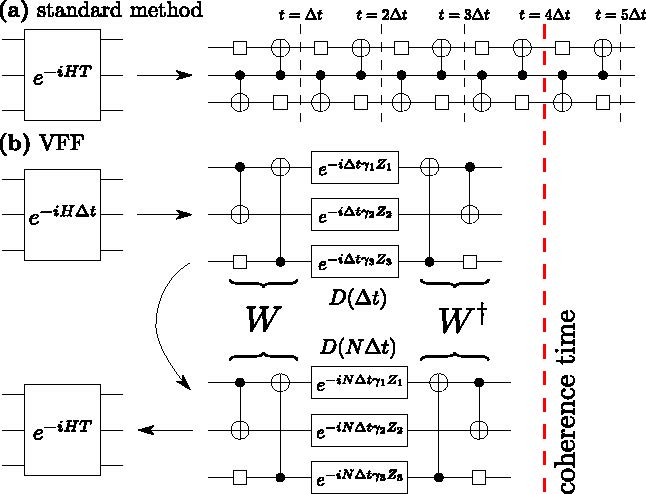
The concept of VFF is illustrated and contrasted with a Trotterization-based quantum simulation with N=5 timesteps (a). This simulation runs past the coherence limit of the quantum architecture. (b) A VFF-based quantum simulation shows an approximate diagonalization of a short-time simulation found variationally.
The variational fast-forwarding (VFF) algorithm, which was detailed in the Nature partner journal Quantum Information, attempts to avoid a major roadblock to quantum simulation via the incorporation of tried-and-true classical methods. VFF is a hybrid quantum–classical mixture that uses an optimization approach to reducing the size of a quantum simulation algorithm, thereby allowing it to perform a quantum simulation before noise destroys the computation. The algorithm pairs classical optimization with a quantum circuit in order to study quantum dynamics in molecular, high-energy, and nuclear particle scattering, superconductivity, topological, and other condensed matter systems.
“Our VFF algorithm essentially allows us to compute the evolution of a quantum system for arbitrary times with a single, short-length quantum circuit,” says Andrew Sornborger, Information Sciences (CCS-3).
This quantum circuit implements the quantum simulation algorithm and for certain systems can perform the computation before the quantum information is destroyed by noise. Longer circuits are prone to more noise, but the VFF algorithm reduces circuit length by transforming the structure of the algorithm.
It is important to note that performing all of the tasks on a classical computer would be incredibly computationally expensive and inefficient. Even supercomputers, which are souped up versions of classical computers, are not well equipped to deal with solving these types of problems. Quantum computers, on the other hand, are exponentially more efficient at simulating quantum mechanical systems. What they lacked was a means to preclude the noise accumulation that comes with longer circuits.

(a) An input Hamiltonian is transformed into (b) a gate sequence associated with a single-timestep Trotterized unitary. (c) The unitary is then variationally diagonalized by fitting a parameterized factorization. This variational subroutine employs gradient descent to minimize a cost function, whose gradient is efficiently estimated with a short-depth quantum circuit called the Local Hilbert–Schmidt Test (LHST). The variational loop is exited when a termination condition is reached. (d) After the termination condition is reached, the optimal parameters are used to implement a fast-forwarded simulation.
With VFF, longer simulations are implemented within a fixed computational time. This is the key to making extant quantum computers, with limited numbers of qubits (or quantum bits), as useful and as functional as possible. Even when the number of qubits increases over time, the VFF method will still be an important technique for reducing noise and increasing efficiency. It is a significant breakthrough.
The Los Alamos researchers were invited to write about their VFF algorithm in SIAM News, the Society for Industrial and Applied Mathematics international news forum. They also detailed a second algorithm, variational Hamiltonian diagonalization (VHD), developed to correct an error that occurred in the VFF algorithm due to its approximation of short-time evolution with a Trotter method. VHD avoids this error by directly diagonalizing the Hamiltonian of the system of interest instead of the quantum simulation unitary operator that governs the system’s short-time evolution. The researchers demonstrated VFF for the Hubbard, Ising, and Heisenberg models on a simulator as well as demonstrating VFF for simulation beyond the coherence time on a Rigetti quantum computer.
Together, the VFF and VHD algorithms allow scientists to harness the power of quantum computing right now, which will impact basic science, technology, and beyond.
Funding and mission
This research was sponsored by the LANL Information Science & Technology Institute (ISTI), the ASC Beyond Moore’s Law program, as well as a LANL Laboratory Directed Research and Development (LDRD) award. The work supports the Laboratory’s Energy Security mission area and the Integrating Information, Science, and Technology for Prediction capability pillar.
References:
Cristina Cirstoiu, Zoe Holmes, Joseph Iosue, Lukasz Cincio, Patrick J. Coles, and Andrew Sornborger. "Variational fast forwarding for quantum simulation beyond the coherence time." npj Quantum Information 6, no. 1 (2020): 1–10. https://doi.org/10.1038/s41534-020-00302-0
Commeau, Benjamin, Marco Cerezo, Zoë Holmes, Lukasz Cincio, Patrick J. Coles, and Andrew Sornborger. "Variational hamiltonian diagonalization for dynamical quantum simulation." arXiv preprint arXiv:2009.02559 (2020).
“Fast-forwarding Quantum Simulations.” SIAM News. Dec. 8, 2020.
Technical contact: Andrew Sornborger
Sigma
Experimental technique offers decades worth of corrosion data in one minute
Los Alamos researchers created an atomically thin coating that protects materials, such as metals, from corrosion. Simulation indicates that this graphene coating will continue to protect surfaces for decades, but the researchers wanted to experimentally prove the concept without having to actually wait that amount of time.
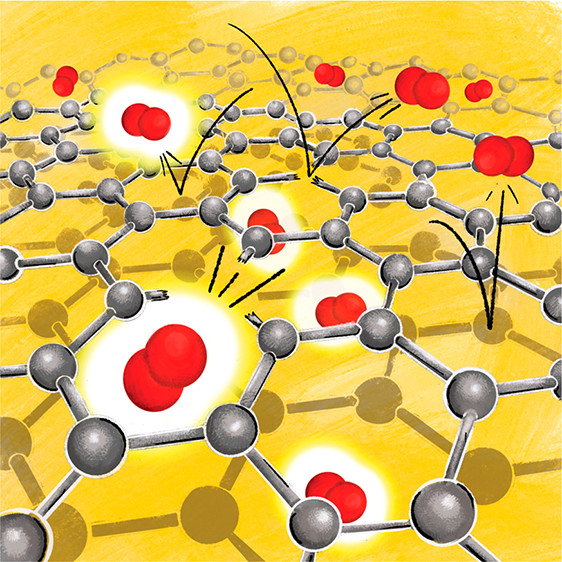
The research was featured on the cover of The Journal of Physical Chemistry Letters. The graphic demonstrates oxygen (non-glowing red spheres) bouncing off the graphene coating, and energized oxygen (glowing red spheres) penetrating the coating.
“We use chemical vapor deposition to deposit a single-atom-thick layer of graphene onto a surface,” says Hisato Yamaguchi, Finishing Manufacturing Science (SIGMA-2). “But to accelerate the corrosion process that happens naturally over time, we created extra-corrosive air and observed the effects.”
Corrosion of metal products, especially cars, planes, and ships, in the U.S. alone is estimated to cost about three percent of the gross domestic product and likely drains trillions of dollars from the global economy. There is a clear market for a durable coating that can protect these surfaces for years on end, and the Los Alamos technology, called Atomic Armor, showed so much promise it garnered an R&D 100 Award in 2019.
To accelerate the corrosion process, the researchers used in situ synchrotron X-ray photoelectron spectroscopy to record the interactions between gas molecules of interest (such as oxygen), graphene layers, and underlying substrates as the coating was exposed to energized air.
“We created a portion of air artificially, including oxygen with a physics-defined energy distribution, and exposed that to graphene-protected metals,” Yamaguchi says.
The researchers found that oxygen molecules imparted with kinetic energy—enough to make them energetic but not enough to break chemical bonds in the coating—permeated the graphene freely and non-destructively. However, non-energized oxygen bounced off the graphene coating, demonstrating the protective ability of the coating.
A dissociative mechanism theory was attributed to the energized-oxygen penetration. Based on force field molecular dynamics simulations, some carbon–oxygen bonding formed briefly. Several simulation movies created by Edward Holby (SIGMA-2) were published with the research in the Journal of Physical Chemistry Letters.
Funding and mission
This work was supported by the U.S. Department of Energy Office of Science and the Japan Society for the Promotion of Science KAKENHI. The research supports the Laboratory’s Energy Security mission area and the Materials for the Future capability pillar.
References: Shuichi Ogawa, Hisato Yamaguchi, Edward F. Holby, Takatoshi Yamada, Akitaka Yoshigoe, Yuji Takakuwa. “Gas Barrier Properties of Chemical Vapor-Deposited Graphene to Oxygen Imparted with Sub-eV Kinetic Energy,” J. Phys. Chem. Lett. 2020 DOI: https://pubs.acs.org/doi/10.1021/acs.jpclett.0c02112
Related article: “Los Alamos scientists find a way to quickly test rust on graphene-protected cars, planes, ships” https://www.lanl.gov/discover/news-release-archive/2020/October/1029-graphene.php
Technical contact: Hisato Yamaguchi
X-Computational Physics
New ICF platform and high-res imaging provide groundwork for direct drive multi-shell targets
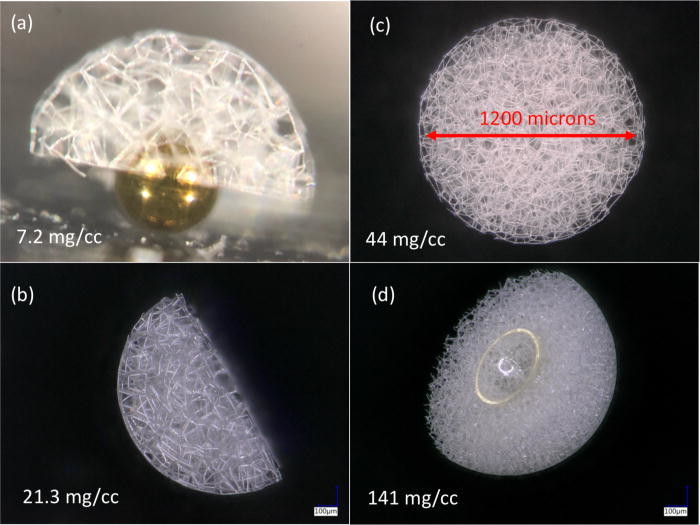
The 2PP lattice structure was created in varying densities: (a) 7.2 mg/cc, (b) 21.3 mg/cc, (c) 44 mg/cc, and (d) 141 mg/cc.
In a Physics of Plasmas editor’s pick, Los Alamos researchers and their University of Rochester collaborator detail a new inertial confinement fusion (ICF) platform and accompanying diagnostic technique. The work is foundational for achieving efficient and symmetric energy transfer to the inner shells of direct drive multi-shell targets.
ICF facilities, such as the National Ignition Facility and the Omega Laser Facility, use lasers to heat and compress targets in an effort to achieve fusion ignition, unleashing massive energy gains. Researchers continue to inch closer to achieving this lofty goal, and multi-shell targets have shown promise in reducing the magnification of asymmetries compared to conventional hot-spot ignition. However, the addition of shells does necessitate the need for low-density fabrication techniques to concentrically hold the shells together.
That is why the Los Alamos researchers introduced a new type of support structure to go between the inner and outer shells of the target. The low-density design helps reduce energy loss as the shells collide during their implosion. The support structure is a two-photon polymerization (2PP) 3D-printed lattice that can be precisely tailored to the user’s needs, and it is the first demonstration of a low-density support for ICF using an additive manufacturing fabrication technique.
To evaluate the inner shell and lattice structure post-collision, the researchers used high-resolution Fresnel zone plate images. This was also a first—enabling the observation of the fine details of the lattice. They compared multi-shell target results with and without the lattice support structure.
The research serves as a proof of concept for diagnosing fine features on the inner shell of multi-shell targets with and without support structures. Future work will look toward more finely-structured supports because the size of the current lattice structures reported induces implosion non-uniformities. The researchers are simulating the struts of the lattice—aiming to fabricate struts fine enough to quickly dissemble, producing an efficient and uniform implosion of the shells.
Funding and mission
This research was funded by a LANL Laboratory Directed Research and Development (LDRD) award. The work supports the Laboratory’s Energy Security mission area and the Complex Natural and Engineered Systems capability pillar.
Reference:
Brett Scheiner, Mark J. Schmitt, Derek Schmidt, Lynne Goodwin, and Frederic J. Marshall. “Two-photon polymerization printed lattices as support structures in multi-shell ICF targets: Platform development and initial assessment.” Physics of Plasmas 27, 122702 (2020); https://doi.org/10.1063/5.0027820
Technical contacts: Brett S. Scheiner and Mark J. Schmitt


